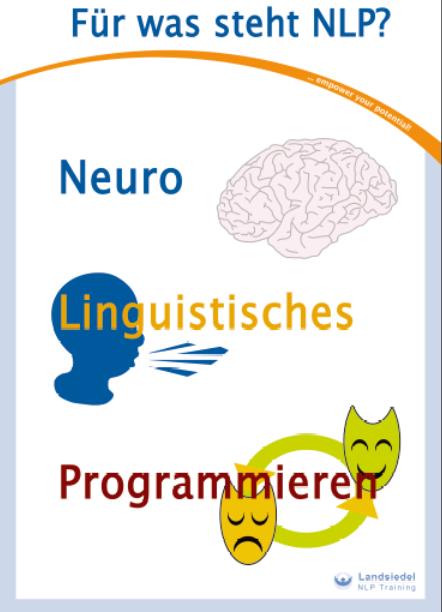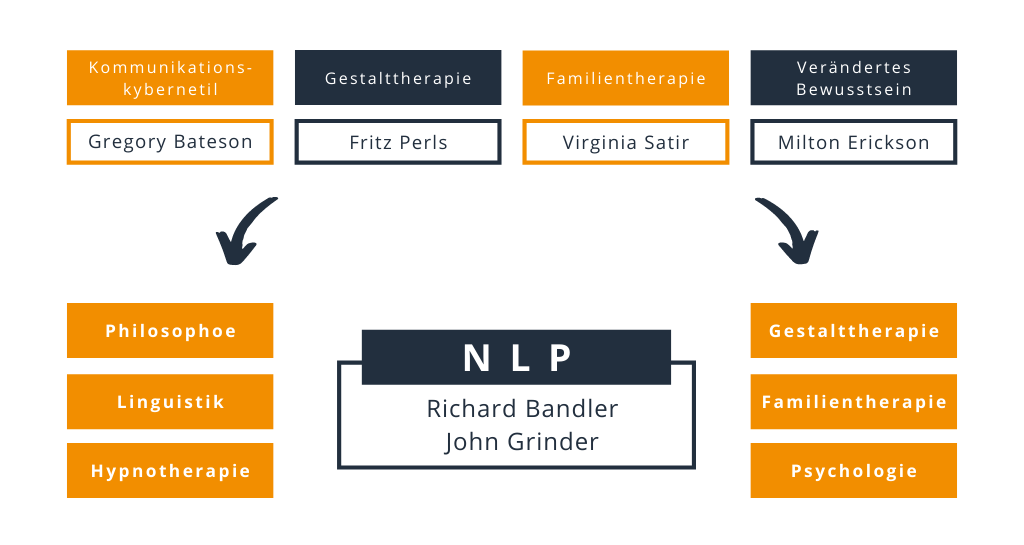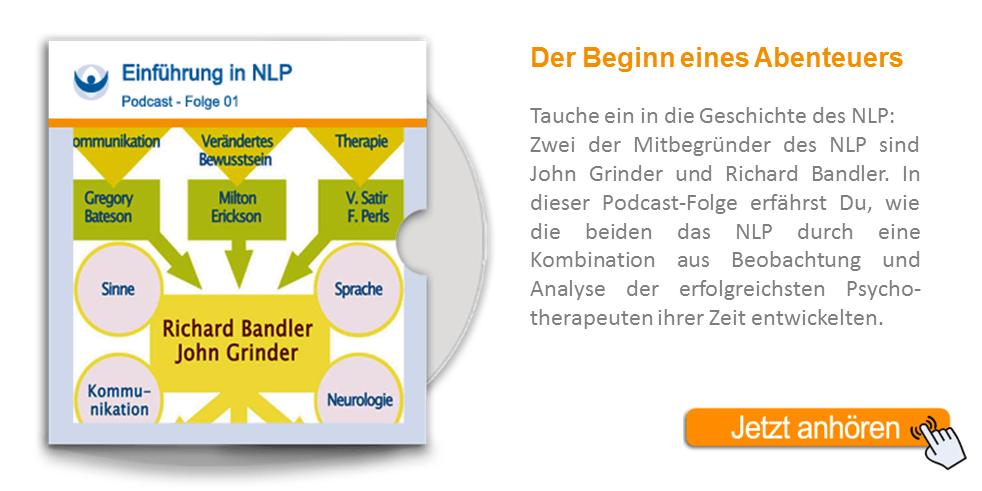Introduction and Overview of NLP
NLP is a modern communication tool and an instrument for changing one’s own personality. It can be applied in therapeutic settings, business contexts, and many other areas. Here you will get an overview of NLP content, assumptions, founders, history, learning stages, and definitions of NLP.
- What does NLP mean?
- Definitions of NLP
- Overview graphic NLP foundation and roots
- History of NLP
- The Prince and the Magician
- Model of learning stages
- Presuppositions of NLP
What does NLP mean?
NLP stands for Neuro-Linguistic Programming. Here are the three components of the name explained:
Neuro, Linguistic, Programming.

Neuro
Stands for our nervous system. Every behavior is controlled by neural processes. Our perception occurs through our five senses. The information is transmitted through our nervous system within our body. Our nervous system includes our brain and spinal cord. From there, our thinking, feeling, and behavior are controlled.
Linguistic
Through our language, we communicate with other people. At the same time, communication also takes place within ourselves. So we have both external and internal communication.
Programming
Our learned behaviors and thought patterns can be changed through targeted intervention. We can program ourselves toward desired behavior. Change doesn’t have to be left to chance but can occur systematically.
Definitions of NLP
Here you will find classical as well as simplified definitions that give you a first idea of what NLP is.
NLP stands for Neuro-Linguistic Programming and is a communication and motivation model developed in the USA in the 1980s. It was developed by linguistics professor John Grinder and mathematician and gestalt therapist Richard Bandler through modeling outstanding therapists and can now be applied in almost any area of life—leadership, therapy, sports, health, sales, rhetoric, and relationships.
NLP offers a variety of methods to become aware of and further develop one’s emotions, behaviors, and thought patterns in a goal-oriented and constructive way. It also provides many opportunities to discover and expand personal strengths and abilities.
NLP can be understood as a method that helps people become aware of their own and others’ perceptions, expressions, and automatic thought and behavior patterns—and to expand or change them using their inner, sometimes unconscious potential. The term encompasses long-standing research into the structure of subjective experiences (how people perceive and respond to the world), communication (how people express themselves linguistically and understand each other), and behavior patterns (how people store and repeat learned things automatically). Special attention is paid to the strategies of successful people, which are described precisely and made accessible and learnable for anyone who wants to. The insights and content of NLP contribute to improving communication between people and provide many techniques for goal and solution finding in problem situations.
"The NLP Practitioner File" by Trageser and von Münchhausen, 2003.
NLP is the art and science of personal mastery, effective communication, and peak performance. “Art” because everyone brings their unique personality and style to what they do—and that can never be fully captured in words or techniques. “Science” because there is a method and procedure to discover the patterns used by outstanding individuals in various fields to achieve exceptional results. This process is called modeling, and the patterns, skills, and techniques discovered are increasingly applied in counseling, education, and business for more effective communication, personal growth, and accelerated learning. NLP is a practical skill that helps us achieve the results we truly want in the world while creating something valuable for others.
"Neuro-Linguistic Programming: Successful Communication and Personal Development" by Joseph O’Connor and John Seymour, 1994.
Overview Graphic – NLP Foundation and Roots
This overview graphic shows the founders of NLP, the disciplines, and the original experts who were modeled.

Fields of Application

History of NLP
On this page, you will find a brief overview of the history of NLP, who the involved people were, and how NLP developed. A detailed presentation can be found on the page History of NLP.
The history of NLP began in the 1970s when the two American scientists Richard Bandler and John Grinder met. John Grinder was then an assistant professor of linguistics at the University of California in Santa Cruz, USA. The two decided to find out how experts achieved outstanding performance in specific fields while others failed. They took these successful people as models and analyzed the patterns they used to achieve their desired goals.
Grinder and Bandler became famous mainly for modeling four fascinating personalities: Dr. Milton Erickson, probably the most influential hypnotherapist in the world; Virginia Satir, an extraordinary family therapist; Fritz Perls, the father of Gestalt therapy; and Gregory Bateson, a brilliant philosopher and anthropologist.
After recognizing the patterns of these masters of communication, they began teaching and further developing them in workshops and seminars.
Today, NLP has spread worldwide and is used in various fields such as therapy, relationships, sales, sports, and education.
The Prince and the Magician
A beautiful but not easy story for a basic understanding of NLP’s concept of truth. The world is our subjective construction. The story: The Prince and the Magician
Model of Learning Stages
The model of learning stages describes the developmental steps our learning process goes through.

| Unconscious Incompetence One has never thought about something and therefore has not consciously noticed that one cannot do it. | e.g. A person rides in a car but has never considered getting a driver’s license. |
| Conscious Incompetence Realization that one cannot do something (so one must learn and practice if one wants to be able to do it). | e.g. One wants to get a driver’s license and sits at the wheel of a car for the first time. |
| Conscious Competence Conscious acquisition and application of newly learned skills. | e.g. One still needs to focus fully and consciously pay attention to everything while driving. |
| Unconscious Competence Automatic and unconscious application of the new skills. | e.g. Driving becomes so automatic that one can have a conversation at the same time. |
Presuppositions of NLP
In NLP, several useful presuppositions have been formulated. These are not objective truths, but they facilitate communication with others and make life easier. Here you can find the Presuppositions of NLP.
Working with Beliefs
Blocks to success often lie within ourselves. Sometimes they are completely unconscious, but often they appear as sentences that come to mind when we start a project or receive an assignment. These are beliefs such as “I’m too young/old. I don’t have money. I’m not qualified enough. I don’t have the right connections. I don’t deserve it.” Our beliefs form the backbone of our reality constructions. Learn what influence these sentences have on your life, how they arose, and how you can change them in yourself and others. Train yourself to create more useful beliefs. You can use many techniques and methods for this, including Sleight-of-Mouth Pattern, Dickens Pattern, New Behavior Generator, and many others.
Working with Values
Values such as freedom, love, honesty, or success are our inner motivators. They ultimately determine and guide our actions. Wars are fought, pain endured, and people destroyed because of them. Yet most people are not even aware of their own values, let alone those of their partners, friends, or clients. Often, we get into conflicts when our values are not in clear order, and our highest values call for opposite actions—for example, between career and family.
In this block, you will learn how values develop and how to find out your personal value hierarchy. You will explore your value conflicts and life rules and practice discovering your partner’s or colleague’s values and rules in conversation. When you act in alignment with your values, you will feel a new, strong energy within yourself.
Advanced Hypnosis Techniques
Advanced methods of clinical hypnosis are trained: trance inductions and phenomena, post-hypnotic suggestions, ideomotor signals, self-hypnosis, advanced metaphor development methods, and the use of trance elements in everyday communication.
Meta Programs
Meta Programs are person-specific perceptual filters visible in behavior. They process, shape, and structure the information from the outside world that we allow inside. Learn to recognize and use these programs in yourself and others.
Advanced Life Design
With advanced Time-Line methods, you will design your life further, work through traumas, and shape your future.
Modeling
Learn how to replicate human excellence at an advanced level. This block completes the circle from the beginnings of NLP to its current applications. You will learn how to identify and use the patterns of successful people for yourself and others.
After completing the Master Practitioner, participants know all essential NLP techniques. In a test, both theoretical and practical knowledge are examined. Additionally, for the Master Practitioner certificate, an independent project on a small topic is required. The topic can be chosen freely or suggested by the trainer. The Master Practitioner certificate entitles participants to take part in NLP Trainer Training.

 Deutsch
Deutsch English
English Français
Français 中文
中文 Español
Español नहीं
नहीं Русский
Русский